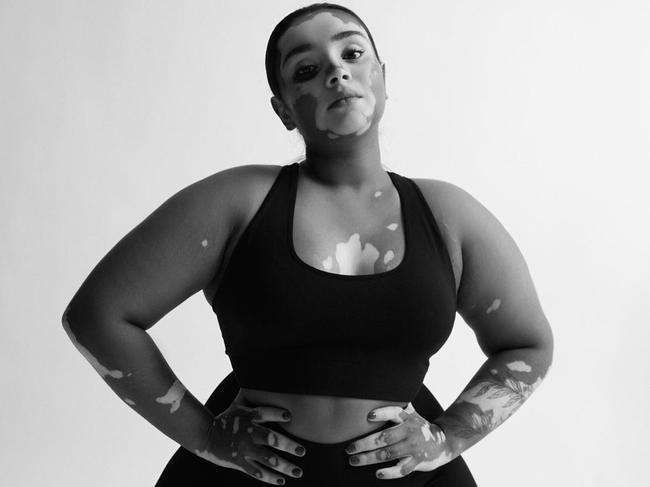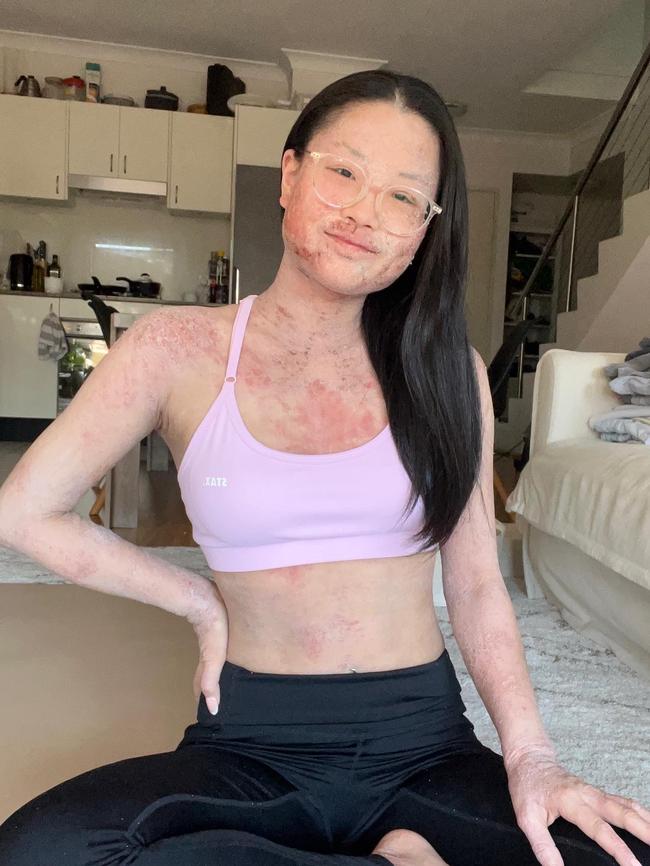4 people on living with a skin condition
Faced with lifelong conditions, these four women have each forged an inspiring path to self-love and acceptance.

Faced with lifelong conditions, such as vitiligo, eczema and Crohn’s disease, these women have reclaimed their identity. Follow their path to self-love and acceptance below:
Onella Muralidharan, vitiligo
“One of my earliest memories as a kid is standing in the hot afternoon sun, covered head to toe in oil. When I was young, my mum would make me do this all the time in an effort to recover the pigment in my skin. I was born with vitiligo – an auto-immune disease that kills off the pigment in my skin cells. I don’t blame her for it. I was born to Sri Lankan parents in Bangladesh, and in 1999, if your child’s skin is starting to change like mine was, it’s a scary time for any parent. My parents always had this view of wanting to cure me, of wanting me to be ‘fixed’.

“It was the little things. Throughout my life, my parents would always make me wear stockings under a dress. When I was seven, my mum put foundation on my face to cover my spots. I hated it. Once I moved to Australia, and I had clearance from my doctor, I did UV treatments to slow and reverse the spread of my vitiligo. Three days a week, from age 12 to 17, my dad would drive me to the dermatologist. And while it worked in some places, I knew my natural skin tone would never come back everywhere. Then, when I was 17, I stopped. In the end, it was a relief to go, ‘Okay, I can just live, I can just be myself.’
“Now I understand I don’t need to be cured. This is just how my skin is and always will be. Of course, I will always sort of look out for the other medical things that come along with having an auto-immune disease, like being immunocompromised. But outside of that, I’m lucky to accept myself as I am.
“As for my changing skin, at the moment, I just find it fascinating. When I was younger, I remember looking at the skin between my top and middle knuckle, and noticing those marks had travelled further and further down. I remember thinking, ‘Oh no, that’s a bad thing.’ I was really conditioned by my parents. But now, I understand it doesn’t really matter.”
Tayla Clement, Moebius syndrome

“I was born with a rare neurological disorder called Moebius syndrome. It affects my sixth and seventh cranial nerves, and that means that my eyebrows don’t move, my eyes don’t track from left to right, and my upper lip doesn’t move, which means I ‘can’t smile’. For so long, that’s what I was told. Not only by doctors, it’s how people used to bully me. ‘Oh, there’s the girl who can’t smile.’ But I definitely can smile. It’s just my own smile.
“I pride myself on the fact I have Moebius syndrome. But it wasn’t always that way. There wasn’t a time in my life where I was aware that I had ‘something wrong with me’. When you’re young, you’re impressionable, you just believe what everyone else says about you. I was in this mindset for the first 20 years of my life.
“When I was 11 or 12, I had a super-invasive operation to try to ‘fix’ my smile. It was eight hours long – they took tissue from my thigh and inserted it from the corners of my mouth up into my temples. In my head, I thought it was the answer. If I get the surgery, I’m not going to get bullied anymore. I don’t think I was ever told that it didn’t work … But I remember, six days after the operation, I looked in the mirror for the first time. I got this massive lump in my throat. I’ll remember that feeling forever, because I think I fully realised that it hadn’t worked.
“At 20, I was so incredibly depressed, I had no hope, I hated everything about my life, including the fact that I couldn’t smile. I had this voice in my head, saying, ‘You’ve got two paths you can go down. You don’t know how it’s going to turn out, you don’t know what’s going to happen, but at least you’re gonna try.’ I think people think it happened overnight, but it didn’t. I spent the good part of three or four years working tirelessly to make sure that I was creating these new habits. Now, I know who I am. I know what I want out of life. I know what I have to offer other people. And I think in that sense, I’m unshakeable. There’s really nothing anyone could say to me to deter me from the fact that I know I belong here on this earth. I was born the way I was for a reason. And I’m so grateful for that because it allows me to help others. My smile is what makes me, me.”
Remi Tsunashima, eczema, topical steroid withdrawal (TSW)
“When I was little, my mum used to give me spare shirts to go to school with so that I could change, that’s how bad my eczema was. Fast forward to high school, I was using steroid creams a lot and my skin was well under control. And at that point, I had no idea what topical steroid withdrawal, or TSW, was, until I came across a video of a girl going through it. I started looking into it myself and found out it’s a drug withdrawal that happens to people using steroid creams over a long time.

“When you’re pregnant, you have to stop using steroid creams. I started thinking about my future and I thought, ‘I don’t want to go through this during pregnancy.’ After making that decision, I went cold turkey and almost overnight, my skin went into withdrawal. I was covered in rashes and open, flaking skin. Wearing my clothes hurt, the wind hurt, I couldn’t lie down on the bed at night to sleep. My mum would come and visit on her days off and wash my hair for me, because it was too painful for me to do it myself. I quit my job, I didn’t go out very often, I could not make eye contact with anyone. I was constantly looking down.
“Nearly a year into TSW, my skin wasn’t getting better. When I started talking to my parents about what I should do, I felt so lost. Something that my dad said really sunk in. He said, ‘Just like how people need water to survive, some people need medication to survive. And that’s okay.’ That changed my perspective. When the doctor saw me, she was really worried about the infection that I had – that’s how I ended up in the hospital. They started me on wet wrap therapy, and they put me on an immunosuppressant.
“During TSW, showering was a traumatic experience for me, because it was so painful to stand under the spray. In hospital, I had a pain-free shower for the first time in a year. It was something that I was dreaming of doing after healing from TSW, I was bawling my eyes out.
“TSW is not a linear healing process. One day you get better and then the next day you flare up. It’s unpredictable. Going through TSW, I realised my body’s not my enemy. It’s on my team. During TSW, I used to look back to my old photos, wishing that I was that girl again. But after going through TSW, I was able to really love myself and appreciate my body for all that it is – and, yes, even the things it isn’t.”
Jordan Lambropoulos, Crohn’s disease
“Prior to my diagnosis, I had never heard of Crohn’s disease. But after being diagnosed at nine, that changed quickly.
“I was on a form of chemotherapy for three years. I got to the point where, because my disease was not responding to medication, I had open bowel surgery when I was 16. I have since undergone 13 separate surgeries on my bum because I live with perianal disease, and I also have a colostomy bag. Just recently, I underwent a stem-cell transplant, which has never been done for Crohn’s before in Australia.

“To live with, Crohn’s is incredibly unpredictable. It’s very difficult to adapt to and it’s very difficult to form any sort of routine. In the past six months to a year, I’ve gone from being someone who can, on the exterior, look healthy – Crohn’s is known as an invisible illness – then in the past year, having a colostomy bag, losing all of my hair, losing most of my eyebrows … When I came out of the hospital from my stem-cell transplant, one of the first things I noticed when I looked in the mirror, was that I didn’t recognise myself. When I was going through the transplant, it was different. I was medicated, I was too busy focusing on surviving that I didn’t bother looking in the mirror and thinking about how I looked. But when I got out of hospital, I had lost 10 kilos, I had no hair, no eyebrows. Even now, I find it hard to come to terms with how I look. It still doesn’t feel like me, the me that I know. But I guess something that I really did learn was that our identity should not depend on our appearance, because our identity is so much more than that. Our identity is in the things that make us smile, the things that make us laugh. It’s in our brains, in our souls, in our hearts, the way that we treat others.
“I’ve always been big on advocacy and talking about my condition, because I think it’s something that’s so stigmatised, and we need to talk about it more, especially the things like having a colostomy bag. If people feel ashamed, they feel stigmatised, they feel isolated. When I was 15 years old and had my first bowel surgery, I said to the surgeons, if you are going to give me a bag, don’t bother waking me up. Because I would have rather died than have a colostomy bag. And now at age 25, I’m trying to make the content that I would have liked to have seen when I was 15 years old and facing that prospect, trying to be the person that I needed at the time.”
This article appears in the August issue of Vogue Australia, on sale now.


To join the conversation, please log in. Don't have an account? Register
Join the conversation, you are commenting as Logout